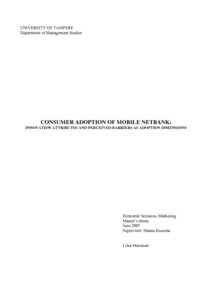Consumer adoption of mobile netbank : Innovation attributes and perceived barriers as adoption dimensions
MASSINEN, LIISA (2007)
MASSINEN, LIISA
2007
Yrityksen taloustiede, markkinointi - Marketing
Kauppa- ja hallintotieteiden tiedekunta - Faculty of Economics and Administration
This publication is copyrighted. You may download, display and print it for Your own personal use. Commercial use is prohibited.
Hyväksymispäivämäärä
2007-06-14
Julkaisun pysyvä osoite on
https://urn.fi/urn:nbn:fi:uta-1-17076
https://urn.fi/urn:nbn:fi:uta-1-17076
Tiivistelmä
TamPubissa tutkielman rajattu versio.
The PDF is a limited version of the Master's thesis.
Mobile netbank was developed approximately one year ago to facilitate the use of mobile banking services with browser based mobile phones and to enable consumers to conduct banking whenever and wherever needed. However, the success of mobile commerce hinges on consumer willingness to adopt services based on new technologies. This thesis focuses on understanding and explaining the adoption process of mobile netbank by customers of Nordea Bank Finland Plc.
The thesis applies the dominant technology adoption theories: the technology acceptance model in consumer context (c-TAM), the adoption process of an innovation as well as the innovation resistance point of view, and tests their applicability in explaining mobile netbank adoption. Furthermore, the established technology acceptance models are enhanced by a new factor: perceived trust, which originates from the disciplines of consumer behavior in the use of financial services and which addresses the issues specific to mobile technology and mobile financial services adoption.
The empirical data of this thesis consist of a quantitative data set of a hypothetic-deductive approach. The empirical data explore first of all the determinants for consumer adoption of mobile netbank and indicate the importance of the generic attributes of technological innovations in adoption decisions in consumer context. The data establish specific factors of the adoption dimensions, and test measurement scales for the factors, and model and test their relation to the mobile netbank adoption process. Secondly, the data explore the innovation resistance determinants that affect the adoption of mobile netbank, and compare the means of perceived barriers and the intensity of the resistance. Furthermore, the effect of communications on the adoption of mobile netbank and on the consumer’s decision making is explored.
This thesis contributes to the understanding of the adoption of mobile netbank and provides important implications for both academic research and practical development of the mobile netbank service. For researchers, the thesis offers a theoretically constructed and empirically validated model of technology acceptance in consumer context in the case of mobile netbank. This contributes to the understanding and explanation of mobile netbank adoption process. For practitioners, the study offers important information on the innovation attributes and perceived barriers of mobile netbank adoption among consumers, and thus provides guidance for future development of the service and its communication. Finally, this study suggests and lays ground for future research in the area of mobile banking.
Keywords: mobile netbank, mobile banking, technology acceptance, innovation resistance, adoption process, c-TAM
The PDF is a limited version of the Master's thesis.
Mobile netbank was developed approximately one year ago to facilitate the use of mobile banking services with browser based mobile phones and to enable consumers to conduct banking whenever and wherever needed. However, the success of mobile commerce hinges on consumer willingness to adopt services based on new technologies. This thesis focuses on understanding and explaining the adoption process of mobile netbank by customers of Nordea Bank Finland Plc.
The thesis applies the dominant technology adoption theories: the technology acceptance model in consumer context (c-TAM), the adoption process of an innovation as well as the innovation resistance point of view, and tests their applicability in explaining mobile netbank adoption. Furthermore, the established technology acceptance models are enhanced by a new factor: perceived trust, which originates from the disciplines of consumer behavior in the use of financial services and which addresses the issues specific to mobile technology and mobile financial services adoption.
The empirical data of this thesis consist of a quantitative data set of a hypothetic-deductive approach. The empirical data explore first of all the determinants for consumer adoption of mobile netbank and indicate the importance of the generic attributes of technological innovations in adoption decisions in consumer context. The data establish specific factors of the adoption dimensions, and test measurement scales for the factors, and model and test their relation to the mobile netbank adoption process. Secondly, the data explore the innovation resistance determinants that affect the adoption of mobile netbank, and compare the means of perceived barriers and the intensity of the resistance. Furthermore, the effect of communications on the adoption of mobile netbank and on the consumer’s decision making is explored.
This thesis contributes to the understanding of the adoption of mobile netbank and provides important implications for both academic research and practical development of the mobile netbank service. For researchers, the thesis offers a theoretically constructed and empirically validated model of technology acceptance in consumer context in the case of mobile netbank. This contributes to the understanding and explanation of mobile netbank adoption process. For practitioners, the study offers important information on the innovation attributes and perceived barriers of mobile netbank adoption among consumers, and thus provides guidance for future development of the service and its communication. Finally, this study suggests and lays ground for future research in the area of mobile banking.
Keywords: mobile netbank, mobile banking, technology acceptance, innovation resistance, adoption process, c-TAM
